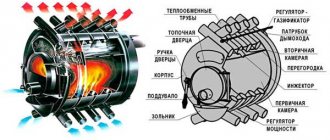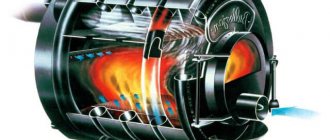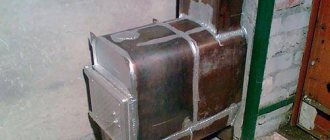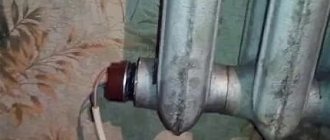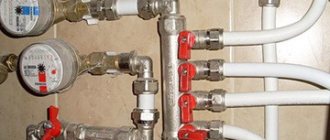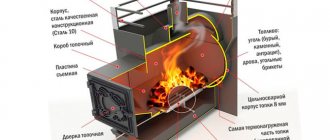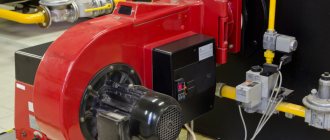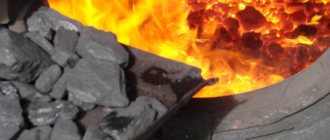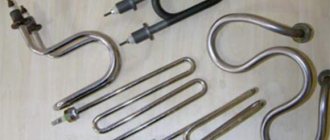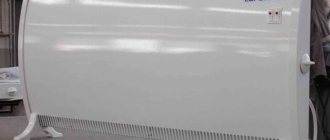From the author: Hello, dear readers! The Buleryan gas generator stove is one of the wonderful devices that can give warmth to a home in the absence of a heating system. This equipment was created by Canadian craftsmen and was originally intended for lumberjacks who spent a lot of time in the forest and needed heating.
Over time, the device migrated to residential buildings. It heats the premises using hot air that comes from the firebox through several pipes. Naturally, in order for the result to meet your expectations, you need to know how to properly heat a Buleryan stove.
In this matter, every nuance is important. For example, the wrong choice of fuel can negatively affect the efficiency of the stove and even its durability. Let's take a closer look at exactly what approach you should take with this interesting device to get the most out of it.
Design and principle of operation of "Buleryan"
This heating unit was developed specifically for mobile teams of Canadian lumberjacks who roam from place to place during the season (winter). Therefore, from the very beginning, high demands were placed on safety and efficiency: the oven must heat the room in a matter of minutes. At the same time, there is no complicated setup or adjustment, the possibility of getting burned should be kept to a minimum, and carbon monoxide should not be allowed to enter the room. On top of that, it's light weight. Here is such a set. And it must be said that “Buler” (one of the names of this design) fully corresponds to them, for which Canadian heating engineers need to say a huge “thank you”.
The design of the Buleryan stove - many interesting and effective solutions
The furnace body has the shape of a cylinder in less powerful models and teardrop-shaped (in cross section) in units for large heated areas. Sinusoidally curved pipes are built into the housing. They are mostly located inside the body, protruding only 1/3 from it. This is done for optimal heat transfer: cold air is sucked into the lower pipes, moving through the pipes it heats up and comes out hot. In the active combustion phase, the output temperature may be 120°C or slightly higher. From 4 to 6 cubic meters are pumped per minute, so the room heats up really quickly.
The firebox is divided into 3 parts. The top and bottom are separated by ¼: at the bottom there are grates made of cast iron or a grate made of thick structural steel (at least 4 mm thick). The upper quarter of the firebox is separated by a steel sheet with holes that occupy about 7% of its area. This partition is installed horizontally and does not reach the door by about ¼ of the length. In this secondary chamber, partial combustion of the gases released during the combustion of wood occurs. The air for this process comes from the firebox through holes in the partition. Therefore, fuel combustion is incomplete (yet). But not the entire process takes place in the furnace; the remaining part of the gases burns out in the pipe.
Cold air is sucked into the pipes from below, which is heated as it moves through the pipe.
The door is wide-format, the fit is sealed, there is a pipe on it with a built-in rotary throttle, which plays the role of a blower. By adjusting its position, the intensity of combustion is changed. Some manufacturers provide this throttle with a scale marked in degrees.
But that's not all the features. The main one is that part of the combustion products of wood occurs in the chimney. From the top of the firebox, unburned gases exit into a horizontal section of the chimney, up to 1 meter long. This section is mandatory for the Buleryans; the combustion of gases slows down a little and they cool down a little. The chimney then turns upward. And here the original Bulerjans have an economizer - a device that completes the process of afterburning pyrolysis gases. With it, the efficiency of the stove is around 80%, and without it - about 60%, which is also not bad, but... In a section of the chimney pipe 15-30 cm long, secondary burnout of gases occurs. The combustion is not constant, but periodic: it flares up and then dies out.
Branded Blerjan with economizer. It is installed at the factory and gives detailed recommendations on how to install the chimney, so you don’t need to invent anything.
To achieve this effect, the pipe is carefully insulated. For this, heat insulators that can withstand high temperatures are used (basalt wool, mineral cardboard, etc., a layer of 3-5 cm, depending on the characteristics of the material). Gases that have not completely cooled down in the horizontal section of the pipe enter this section, where, due to good thermal insulation, a large amount of thermal energy accumulates. The temperature of the gases rises, they flare up again. The flared gas increases in volume, but due to the limited volume, it clogs the lumen of the pipe. A plug of gases forms. All gases burn out, cool and dissolve. Then the process is repeated. Its intensity and frequency depend on the quality of the wood and the throttle position. “Buleryan” itself adapts to these parameters without additional adjustments.
Gate valve at the furnace outlet
A slide valve is installed at the exit from the furnace to regulate the draft intensity. The diameter of the damper is approximately 10-20% smaller than the diameter of the chimney. A sector approximately a quarter of a circle in size is cut out of the damper disk. This plug is welded to a metal rod, with the help of which it is movably attached to the pipe. It is with this gate and throttle on the door that the combustion mode is set. How often the stove “puffs” depends on the fuel and their position.
It is worth agreeing that the Buleryanov device is original and expedient in everything. Very interesting and unusual solutions made these stoves very popular. Moreover, even without the last afterburning in the pipe, they use the device and do not complain: its efficiency is much higher than air heaters of other designs. Added to this is high safety: even leaving the door open, it is impossible to get caught. The same as getting burned on a hot body: in normal operating mode its temperature is only 50-60°C, which is clearly not enough for a burn.
Operating rules for the stove
In order for the operation of the stove to be safe and reliable, it is necessary to carefully prepare the base, comply with all requirements for the installation of the chimney and ensure regular maintenance.
While using the stove, owners should pay attention to the operation of the structure and the appearance of some signs indicating a malfunction.
Here are some typical reasons why a stove starts smoking:
- Insufficient chimney insulation. The convection type of the oven imposes requirements on the smoke exhaust system. It is recommended to use ceramic or sandwich pipes;
- Accumulation of tar on the walls of chimney pipes. It is necessary to clean the chimney at least once a year. low chimney height. Its minimum value is 3 meters. It is also important to correctly calculate the height between the roof ridge and the umbrella.
If you fulfill all these conditions and regularly carry out maintenance work, you can avoid problems with poor draft and smoke.
How to heat properly
The main operating mode of “Buleryan” is smoldering mode (firewood, pellets, wood chips, briquettes). Intensive combustion - only for the first time to quickly heat the room. If combustion is constantly active, the metal will quickly burn out: it was not created for such a regime.
First you need to light the oven. For these purposes, you can use paper, cardboard, pellets, dry wood chips, etc. the main requirement is dry fuel that burns at a high speed. The volume of the bookmark is for 20-30 minutes of burning. Here you need to get used to it: the fuel should turn into coals at a time when the room is almost completely warmed up.
First, add dry, fast-burning fuel.
The fire is lit with the damper and throttle open, and the door is closed. The fuel burns actively and the room heats up quickly: at this time, from 4 to 6 cubic meters of air passes through four pipes per minute, and the outlet temperature is around 140°C. So even a decent room won’t take much time.
You need to observe the process: through the glass in the door or through an open throttle, however, the second method is very inconvenient. When the fuel turns into coals, coarsely chopped firewood is added to the firebox. You can use whole logs of wood, just push them through... You can put in briquettes. What you can't use is coal. The oven is not designed for such temperatures. Bulleryans are a purely wood-burning stove.
Now set the throttle to the mode required (you can go to the extreme position up to the limiter), the damper to the “closed” position (¼ of the chimney cross-section remains open). In this situation, the fuel smolders, and the process proceeds in stages. Air heated to 60-70°C comes out of the pipes, and the furnace body has a temperature of about 50°C.
How not to heat: There is no need to “accelerate” the stove to super high temperatures. And it’s not just that the metal will burn out. It’s just that with this design, most of the heat cannot be transferred to the air through the heating pipes: its thermal conductivity is limited. And all the excess will simply fly away through the chimney into the street. Therefore, the manufacturer categorically does not recommend using coal or coke: it is a waste of money, and besides, the equipment will quickly break down, and the plant will not accept complaints - the operating conditions are violated.
Main types
In addition to quickly warming up the air, the stove adds comfort to the room
There are several options for Buleryan stoves; some models include doors with heat-resistant glass. They are heating equipment that was invented in Canada. Due to the release of large amounts of heat as a result of fuel combustion, these stoves create powerful convection.
The Buleryan mini stove with a water circuit runs on natural fuel - birch wood. It is designed for heating any premises with a volume from 500 to 1000 cubic meters. One stack of firewood is enough for 12 hours of heating.
It can also be heated with peat briquettes, brown coal, and wood waste. When using coal, it must be mixed with other types of fuel.
Installation "Buleryan"
When installing, you must maintain the distances to the walls that are recommended by the fire department. Examples of wall protection and distance to the stove depending on the material:
- wooden unplastered - at least 1000 mm;
- layer of heat insulator 7 mm, and metal on top 1 mm - distance 500 mm;
- non-combustible plaster with a layer of 25 mm and ceramic tiles - 700 mm;
- single brickwork (55 mm) - 500 mm;
- double brickwork (110 mm) - 300 mm;
- a shield made of two sheets of metal 1 mm thick, assembled using non-flammable inserts, the distance between the sheets is 30 mm; The structure is mounted on a wall protected by a layer of thermal insulation - the distance to the walls is 300 mm.
The Bulerjan stove must be installed on a non-combustible base. This could be four rows of bricks laid flat. A clay mixture is used as a solution. The dimensions of the base are 30 cm larger than the parameters of the stove in any direction. To save bricks, you can leave voids in the two bottom rows. Another type of non-flammable base is a metal stand for “Buleryan” made of pipes. Its height is 150-300 mm. For any installation method, a metal sheet must be placed on the combustible floor in front of the stove; its dimensions are: width 500 mm, length 700 mm.
Rules for installing Buleryanov on a flammable floor
When installing the Buleryan stove with your own hands, it is important to make the chimney correctly. They are subject to general requirements (except that it must all be insulated, but this is not a requirement of firefighters, but technological nuances). The chimney pipe can be:
- Brick. Wall thickness 120 mm.
- Concrete with a wall of 60 mm.
- Metal (including sandwich).
The chimney parameters depend on the model. For Buleryan stoves of types 00 and 01, the minimum height is 4 m, cross-section is 120 mm; for models type 02, 03 and 04 - above 5 m, with a cross-section of 150 mm. The chimney must be made airtight, and the joints must be sealed with heat-resistant sealant.
Both types of chimney outlet are allowed: through the roof or into the wall
Both methods of exhausting the chimney are allowed - through the wall and the ceiling. Output to the wall is easier to implement, especially if there are several floors. When exiting through the ceiling, it is necessary to equip a passage unit through the ceiling and roof in compliance with all fire safety measures. The height of the chimney above the ridge is at least 0.5 m.
As you can see, there are no excessive requirements for the installation: you have prepared the place, built a sealed insulated chimney, and you can carry out the first fire. So installing a Buleryan stove with your own hands is possible.
Conclusion
The Buleryan stove is very convenient and useful if you use it correctly. It does not accumulate heat near itself, but distributes it throughout the room. Such boilers can be used in a home, garage, industrial premises or greenhouse. All the tips presented in the article are most useful for people who use the stove all winter.
When choosing a stove, pay attention to the fact that Buleryan has a number of useful advantages - easy installation, cost-effectiveness, long service life, good heating (it is easy to maintain a comfortable temperature). To heat several rooms at once, it is necessary to lay additional pipes. But don’t forget that the Buleryan stove does not run on coal, only on wood fuel.
Combustion depends on many factors - outside temperature, fuel quality, wood moisture content, chimney height, so there cannot be exact instructions for heating. The main thing is to follow the instructions exactly so as not to harm people in the room and not damage the boiler.
Useful operating tips can be found in user reviews, but do not trust them 100% if they are completely at odds with fire safety rules and do not comply with the instructions.
Models
Buleryan heating stoves are produced by different factories in different countries. There is a plant in Ukraine. They produce heating “Bullers” and sauna stoves; there are also heat accumulators compatible with some models.
Ukrainian version. "Bullers"
The technical characteristics of Buleryan convection ovens manufacturer are summarized in the table.
Technical characteristics of Ukrainian-made Buleryanov (click to enlarge picture)
Thermal accumulators are used mostly in greenhouses, where there are almost no walls that accumulate heat in conventional buildings. The hinged panels are made of painted steel plates and completely follow the shape of the stove, so each modification has its own heat accumulator. The device is hung on the tops of the heat exchange pipes and rests on their lower ends. They can be filled with any solid heat-intensive material: broken brick, large crushed stone, pebbles, etc.
Canadian Bulerjan. Models of different power
Canadian Buleryan stoves are also represented in Russia. Their characteristics are summarized in the table. As you can see, the design is different, but the characteristics are the same.
Canadian Bulerjan. Technical specifications (click to enlarge image size)
To top up fuel, you need to:
1. Switch the stove to active combustion mode (open the rear damper, and after 1-3 minutes the front damper) 2. open the door, make a bookmark 3. close the door and close the dampers (front, after 2-3 minutes - rear).
To remove ash, in classic Buleryan stoves, you need to wait until the fuel burns out completely and cools down.
If you are choosing a stove for heating a house, cottage or other facility where cooling the room is extremely undesirable, pay attention to Ognev stoves - they can be cleaned even during operation.
How to heat several rooms
Long-burning boilers "Buleryan" can be used to heat several rooms. To do this, it is not necessary to somehow alter or modernize the unit. You can assemble air ducts and a thermal chamber. Such an air heating system is no less effective than a water heating system, and requires much less money and time to organize.
Assemble the thermal chamber as shown in the figure. You can use galvanized drywall profiles and galvanized sheets. Assemble the frame from the profile. In galvanized sheets, cut holes for the grilles and inspection door, then attach them to the frame. Cover the galvanized surface with thermal insulation (mineral wool mats). Next, the camera can be decorated or not - as desired.
The thermal chamber will allow you to accumulate heat from the stove. From it you can already route air ducts between rooms
Air ducts are connected to the upper outlets for heated air. They can be made of plasterboard, or you can use metal pipes of the appropriate diameter or square ones, as in standard air ducts.
This solution is much more effective than putting corrugation on heat exchange pipes. In the heat chamber you collect all the heat from the furnace and then distribute it through the air ducts. In general, when designing or planning a system, keep in mind that the shorter the ducts, the more efficient the heating will be.
There is one caveat: some people really want to adapt this stove for water heating. Breneran and some other manufacturers of similar stoves even have “Aqua” options. But the operating principle itself is poorly suited for heating water: it has a greater heat capacity than air. The efficiency of such units will not be great. If you want water heating, buy a regular hot water boiler, long-burning or pyrolysis. It will be more efficient.
Price
| Models Buleryan | Cost (r.) |
| AOT-06 type 00 | 10400 — 11500 |
| AOT-08 type 005 | 14700 — 15800 |
| AOT-11 type 01 | 16000 — 17100 |
| AOT-14 type 02 | 20100 — 21200 |
| AOT-16 type 03 | 30300 — 37400 |
| Breneran oven with hob | 12900 — 21200 |
| Bath stoves Breneran | 15400 — 17900 |
| Bath stoves with grate | 16000 — 17100 |
| Aqua-Breneran stove | 36300 |
| Wood and briquette stove Breneran-Aquaten | 16200 — 54900 |
| Breneran stove-fireplace | 24000 — 40700 |
Reviews about "Buleryan"
With reviews, everything is very simple: everyone who uses the stove is satisfied, very satisfied or “nightmarishly satisfied” (the last saying is a quote from one message). The only thing that people are actively discussing is an effective heat distribution scheme for heating a large number of rooms. What they encounter during operation: the accumulation of soot in chimneys, which needs to be cleaned from time to time. Another thing worth remembering (again, from operating experience): you cannot narrow the chimney, then adjusting the Buleryan will be either very difficult or impossible (this is to adjust the position of the damper and throttle for stable combustion and high efficiency).
Where to buy high-quality oven equipment?
- Prompt delivery throughout Russia. Shipping to remote regions is carried out 1-2 days after payment for the equipment.
- Low prices. We work directly with suppliers, eliminating markups from intermediaries, which allows us to make the best offer on the market.
- Warranty from 2 years.
- Quality control and compliance of equipment with domestic and foreign standards.
To buy a Buleryan stove or get advice, contact the company’s managers by phone or leave a request for a call back.
The manufacturer that produces long-burning stoves, Breneran, has accumulated impressive experience in the production of such equipment. These products have decent demand on the Russian market. The company gives a 2.5 year guarantee for the reliability and safety of its products.
The production company Laotherm has been present on the Russian market since 1993. Previously it produced equipment under the Buleryan brand. Since 2005, the products received a modern brand name - Breneran. This company also produces more budget models - Buran stoves. They are in no way inferior to their predecessor.
Price
The unit has a weight of 60 kg and dimensions 455x620x555 mm. Designed to heat a room with a volume of up to 100 cubic meters. m.
Cost: 8 thousand rubles.
This category includes models with power from 6.2 to 34.7 kW.
They are designed to heat rooms with a volume of 100 to 1000 cubic meters. m.
The smallest oven has dimensions 640x436x605 mm (weighs 52 kg), the largest - 950x676x1505 mm (weighs 235 kg).
Cost: from 8.3 thousand rubles. up to 35 thousand rubles.
The line includes models with a power range from 6 to 35 kW. The dimensions of the smallest are 700x450x650 mm (weighs 57 kg), the largest are 1030x770x1200 (weighs 160 kg).
Average cost – 41 thousand rubles.
Efficiency compared to gas heating
Today, gas heating is undoubtedly the best in terms of cost of operation and ease of use. However, in some ways it still loses to Buleryan:
- A gas boiler cannot be connected without the approval of the gas utility.
- The operation of a gas boiler depends on the operation of the gas supply system, while Buleryan is completely autonomous.
Gas fuel is poisonous and explosive. Moreover, due to its volatility, it can easily spread throughout the room. Buleryan in this regard does not pose any danger.
